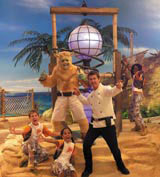Telly scope
Creating an atmospheric set that suits the character of both the programme and the presenters is essential.

Designer Marcus Blee, who created the Hell’s Kitchen set along with Big Brother 3 and 4, The Salon and Popstars: The Rivals, says the challenge is to not simply focus on specifics.
‘It’s important to understand what producers are feeling about a project. You need to get to know those involved and how they feel and what they’re thinking. That’s as important as a prescribed brief,’ says Blee.
‘It ensures you end up with a more holistic set that can house activity, rather than just a backdrop. You can develop a sense of purpose specific to the show.’
Blee says it’s also essential to understand the personality of the presenters and what would make them feel comfortable. ‘The presenter can’t feel incongruous. He or she needs to resonate with the space, the space can’t contradict their personality,’ he explains.
The Hell’s Kitchen set was strongly influenced by presenter Gordon Ramsay’s personality. ‘After meeting him for the first time it took under a minute to come up with the initial idea. The whole design was a knee-jerk reaction to meeting [him],’ says Blee.
But not all set designers are happy with the creative process between programme makers and designers.
With its amphitheatre-style arena and gladiatorial ambience, the set for ITV’s Who Wants to be a Millionaire? uses lighting and sound to generate suspense and delivers a brooding atmosphere to build audience involvement. But its designer, A1 Design’s Andy Walmsley, who also designed the Pop Idol set, has since emigrated to the US, in part because of dissatisfaction with working conditions in the UK.
Walmsley believes producers in Britain often don’t allow enough time and budget for the creative aspects of set design.
‘In the US, I tend to be brought in months before a show hits the studio. I’m working on a project now that doesn’t tape for nine months and that is pretty standard,’ he explains. ‘In the UK, I was often brought in just four weeks prior [to shooting] and that is terrible for the designer and the production.’
As with every type of design then, there are challenges of time and budget. But it seems creativity is the cornerstone, not just in designing formats that are aesthetically appealing, but also in creating effective, working environments within the technological constraints.
Producers’ notes: genre requirements
Children’s TV – A set is a visual playground for children. Designers need to build in activity, rather than creating a flat, one-level, set. ‘Bring in adventure and get the kids moving around the set. Excite viewers,’ advises BBC producer Nigel Stone.
Reality TV – The set needs to feel like a real environment and the design has to hide the technology and cameras. ‘You can’t have the machinery of making TV in shot,’ maintains Hell’s Kitchen producer Richard Cowles.
Light entertainment – As well as generating emotion, designers must be aware of the detailed process of the game. ‘It’s important to consider the number of contestants and how this varies, the props that will be used and the prizes – do you need space for a car, for example,’ says Colman Hutchinson, executive producer of Who Wants to be a Millionaire? and Blind Date.
-
Post a comment




